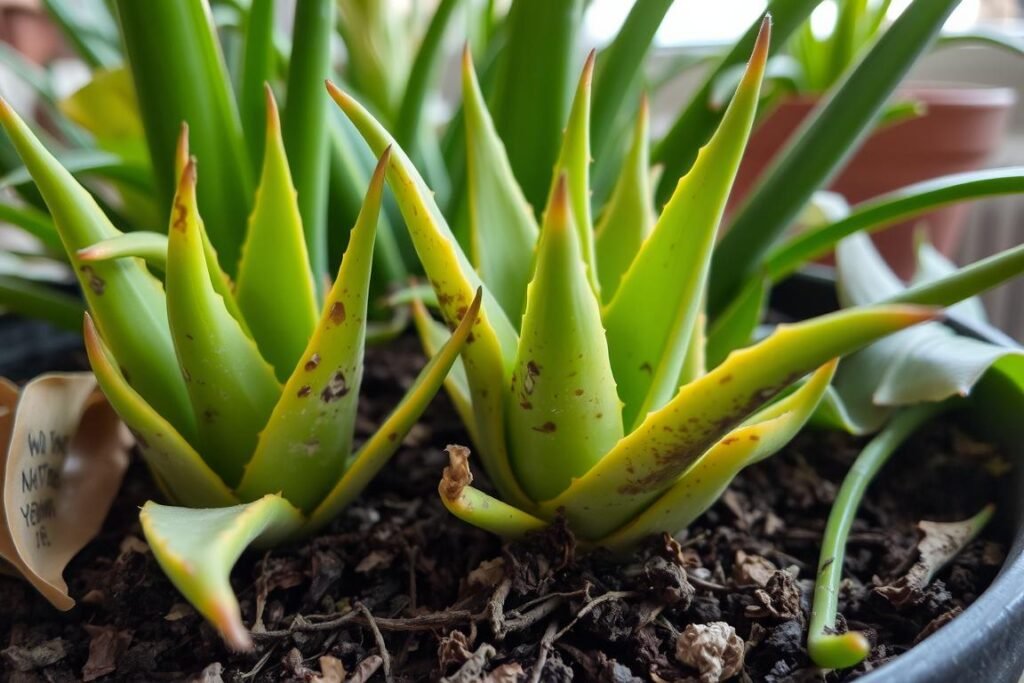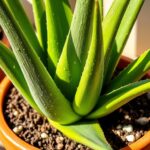I was excited to separate the pup from my aloe vera plant. I had read about how fun it is to grow these plants. But, a few weeks later, I saw the leaves turn yellow and shrivel. I wondered what I did wrong.
Many gardeners face the problem of aloe vera pups dying after repotting. These plants need special care to grow well. Things like temperature and soil can affect their health. But, with the right care, your aloe can survive and grow strong.

Key Takeaways
- Aloe vera pups can die after repotting due to various reasons, including improper soil conditions, root damage, and temperature shock.
- Successful repotting requires understanding the plant’s needs, proper timing, and careful handling.
- Aloe vera plants prefer free-draining compost, bright but indirect light, and infrequent watering.
- Pups should be at least 2-3 inches tall before separation, and the best time to divide them is during winter when the plants are not in their growing season.
- Overwatering and poor drainage are common mistakes that can lead to root rot in aloe plants.
Understanding Aloe Vera Pup Development
Aloe vera plants can grow new little plants at their base. These little plants, or pups, can be taken out and grown into new plants. Knowing how aloe vera pup development works helps your plants grow well.
Identifying Healthy Pups
Healthy aloe vera pups grow at the base of big plants. They should be 2-3 inches tall before you take them out. Look for pups that are bright green and have thick leaves.
Optimal Size for Separation
Pups are ready to be separated when they are 2-3 inches tall. This means they have strong roots to grow on their own. Taking out small pups can hurt their chances of growing.
Root System Development Stages
The aloe vera root system grows as pups get taller. Pups with some roots are ready to be separated. Healthy parent plants make better pups with strong roots.
Aloe vera plants can live up to twelve years. They can make dozens of little plants, making them great for plant lovers.
Common Signs of Aloe Vera Pup Distress
I love aloe vera plants, but they can be tricky. The little pups that grow from them can show stress signs. Spotting these early helps your pup stay healthy.
Wilting or color changes are big signs. If leaves droop or turn red, it might mean they’re stressed. Too much or too little water can cause this.
Stunted growth is another warning. If your pup isn’t growing, it could be due to bad temperatures or light. Or maybe it needs more roots to grow strong.

Watching your pups closely is important. Quick action can help them grow well. Keeping them healthy means more fun for you too.
Why Did My Aloe Vera Pup Die After Repotting
Repotting aloe vera pups is tricky. Sometimes, they get shocked after moving. If your pup died after repotting, there are a few reasons why.
Temperature Shock After Transfer
Aloe vera plants don’t like sudden temperature changes. If you moved your pup to a very hot or sunny spot, it might have died. This big change in temperature was too much for it.
Root Damage During Separation
When you separate the pup from the parent plant, it can be stressful. If the roots get hurt, the pup might not get enough water and nutrients. This can cause it to wilt and die. It’s important to be gentle and not hurt the roots too much.
Improper Soil Conditions
Aloe vera plants need soil that drains well and is sandy. If the soil is too dense or doesn’t drain well, the pup can get root rot or dehydrate. Make sure to use a potting mix made for succulents. It should have a lot of sand or gritty stuff.
To repot your aloe vera pups well, handle them carefully, use the right soil, and help them get used to their new home slowly. Knowing why pups might die after transplanting helps you avoid it next time.

Essential Soil Requirements for Aloe Pups
For aloe vera pups to grow well, they need good drainage. Mix 1/3 sand or gravel with 2/3 potting mix. Or, use equal parts sand and garden soil. For a homemade mix, try one part perlite with two parts compost.
Soil should let water drain fast. Aloe vera plants don’t like too much water. Use cactus or succulent compost for the best results.
“Aloe vera plants can produce masses of offsets, with a single plant generating up to 25 pups for propagation.
Choose the right pot size when repotting. Aloe plants need a 4″-8″ pot every 2-5 years. Let the pups dry for three days after transplanting.
Divide aloe plants in winter when they’re not growing. Pups should be 2-3 inches tall for best results. Follow these tips for healthy, growing aloe pups.

Proper Timing and Techniques for Repotting
Repotting your aloe vera plants is key to keeping them healthy. The best time is in winter when they are dormant. This helps the new plants grow strong roots.
Best Season for Transplanting
Winter is the best time to repot aloe vera plants. The plants are not growing much, which lowers the risk of shock. It also helps them grow roots well in the new pot.
Step-by-Step Separation Process
- Gently remove the parent plant from its pot, keeping as much root as you can.
- Brush off extra soil from the roots to see the pups.
- Use your fingers or a sharp knife to separate the pups from the parent plant. Make sure each pup has some roots.
Healing Period Requirements
Let the separated pups dry and form a callus for 1 to 6 days before repotting. This step prevents disease and prepares them for new roots.
| Pot Size for Aloe Vera Pups | Recommended Pot Diameter |
|---|---|
| Individual Pups | 3-4 inches |
| Mature Aloe Vera Plants | 6-8 inches |
Wait three days after repotting before watering the pups. This lets any cuts heal and prevents root rot. It makes sure the transplant goes well.
“Proper timing and techniques are crucial for successfully repotting aloe vera pups and ensuring their continued healthy growth.”
Critical Watering Guidelines After Repotting
Caring for aloe vera pups after repotting is very important. Wait three days before watering them. This lets any cuts or damage heal, avoiding infection or rot.
After the healing time, watch the soil moisture closely. Water the aloe pups only when the soil is dry. If they’re in small pots and it’s hot, water them lightly every day to keep the soil moist.
Don’t water too much, as aloe vera likes dry soil. Try burying the pot up to its rim. This helps keep the soil cool and moist, which is good for your aloe pups.
| Watering Frequency | Soil Moisture | Pot Size |
|---|---|---|
| Wait 3 days after repotting | Water only when soil is completely dry | Bury pot up to rim to maintain moisture |
| Daily light watering for small pots | Avoid overwatering – aloe prefers dry conditions | Larger pots may need less frequent watering |
By following these watering aloe vera pups and aloe pup care after repotting tips, your aloe plants will recover well. They will be healthy and vibrant.
Optimal Growing Conditions for Newly Repotted Pups
It’s very important to give your aloe vera pups the right place to grow. They need the right amount of light, temperature, and humidity. This will help them grow strong and healthy.
Light Requirements
Aloe vera pups love bright, indirect light. Place them in a spot that gets some shade, like under a tree. This keeps them safe from too much sun.
Temperature Control
Keep the temperature just right for your pups. Don’t let them get too hot or too cold. The best temperature is between 65°F and 85°F.
Humidity Considerations
Aloe vera likes a little bit of humidity. Make sure there’s good air flow to stop moisture from building up. If it’s very dry, use a humidifier to help.
By controlling light, temperature, and humidity, you create a great place for your pups to grow. With the right care, they will grow strong and beautiful.
Prevention and Recovery Methods
To keep your aloe vera pups healthy, you need to act early. Make sure the soil drains well and don’t overwater. Also, keep the plants away from very hot or cold temperatures.
If a pup looks sick, like it’s wilting or turning color, help it fast. Move it to a spot that’s not too sunny. Don’t water too much, as this is the main reason pups die. Water a little and watch the plant closely.
- Be gentle with the pup to avoid hurting its roots.
- Try burying the pot to keep the soil warm and moist. This can help the pup get better.
- Don’t give up on a sick pup too soon. They can get better with the right care.
Fixing the problems early and taking steps to prevent them can help your aloe vera pups. With care and patience, you can save a dying aloe vera pup. Then, you’ll have a beautiful, healthy plant to enjoy.
“Aloe vera plants are remarkably resilient, and with the right care, even struggling pups can make a full recovery.”
Conclusion
To grow aloe vera pups well, you need to know what they need. Use the right soil and separate them carefully. Also, take good care of them after.
By repotting, watering, and keeping the right environment, your pups will do great. Aloe vera plants are tough. They can get better with the right care.
Following this guide will help you grow healthy aloe vera pups. They will make your space look good and clean the air. With some effort, your aloe vera plants will thrive for a long time.
FAQ
Why did my aloe vera pup die after repotting?
Aloe vera pups can die after repotting for many reasons. These include temperature shock, root damage, and bad soil.
What are the signs of distress in aloe vera pups?
Signs of distress include wilting, color changes, and slow growth. Too much water can cause root rot. Not enough water makes them shrivel.
What is the best soil mix for aloe vera pups?
Mix 1/3 sand or grainy stuff with 2/3 potting mix. You can also use cactus or succulent compost.
When is the best time to repot aloe vera pups?
Repot in winter when they are dormant.
How should I water aloe vera pups after repotting?
Wait three days to water after repotting. This lets cuts heal. Then, water only when the soil is dry.
What are the optimal growing conditions for newly repotted aloe vera pups?
They need bright, indirect light and moderate temperatures. Good air and some humidity are also key. Use well-draining soil to avoid root rot.
How can I prevent aloe vera pup death and help them recover?
Prevent death by ensuring good soil drainage and avoiding too much water. Protect from extreme temperatures. If a pup looks sick, move it to a semi-shaded spot. Adjust watering and care gently.






